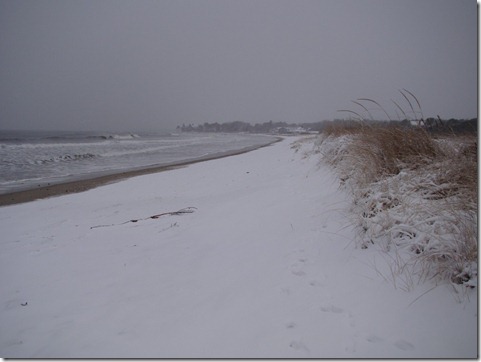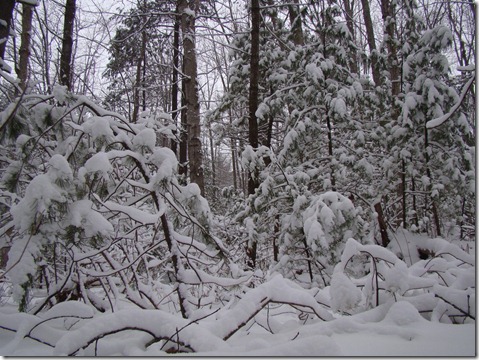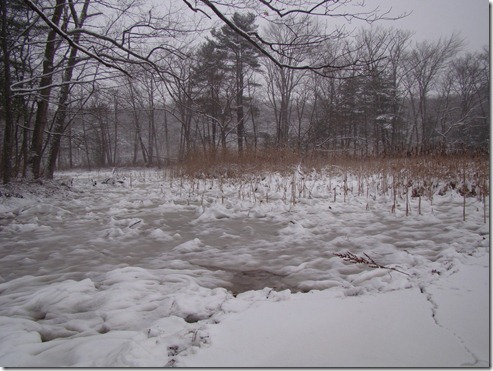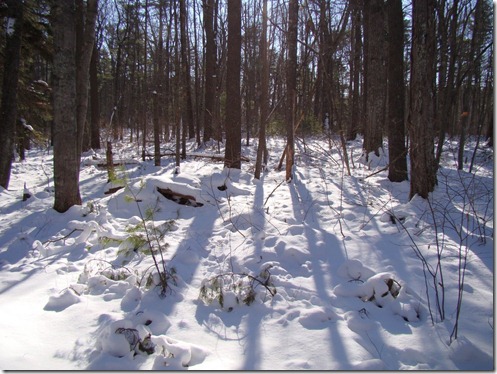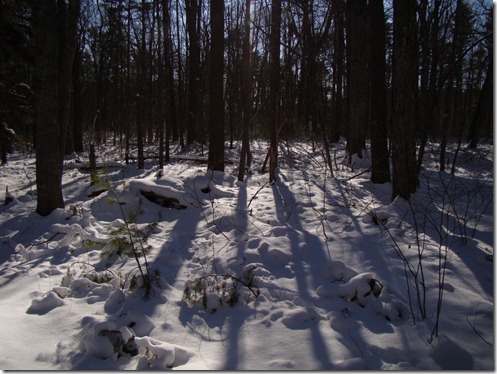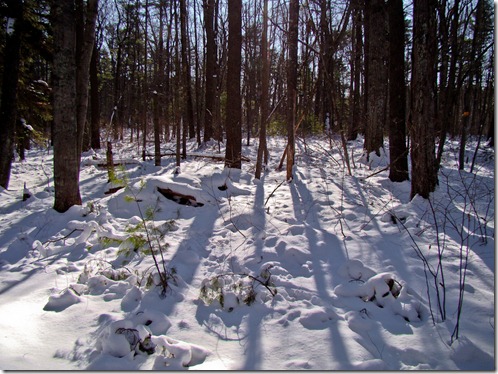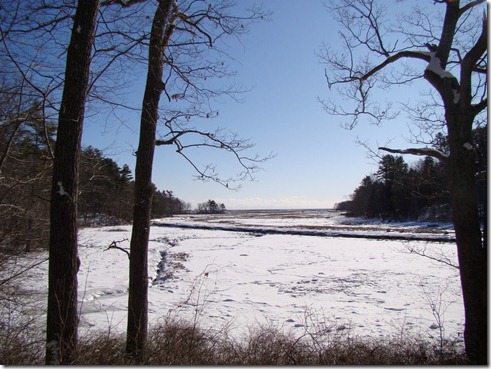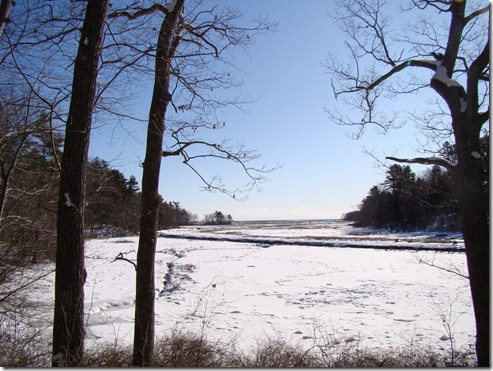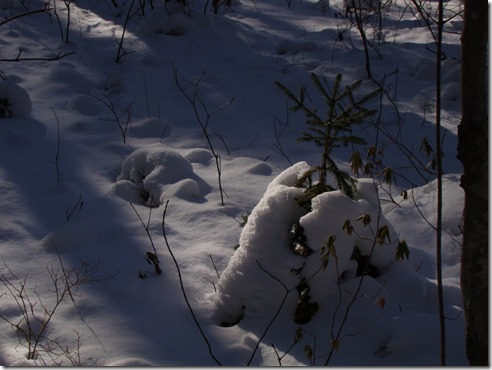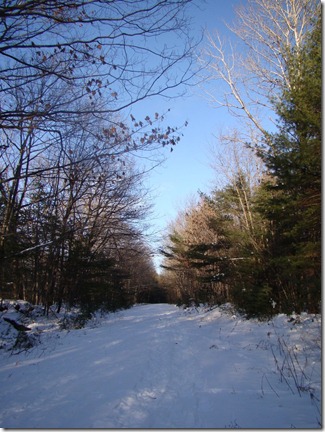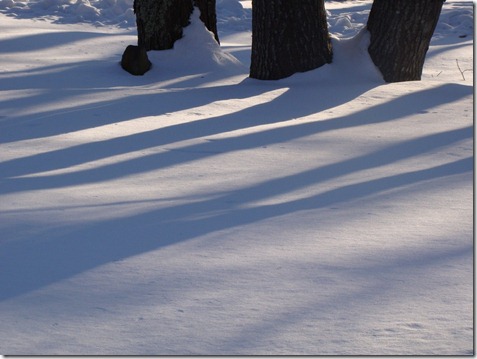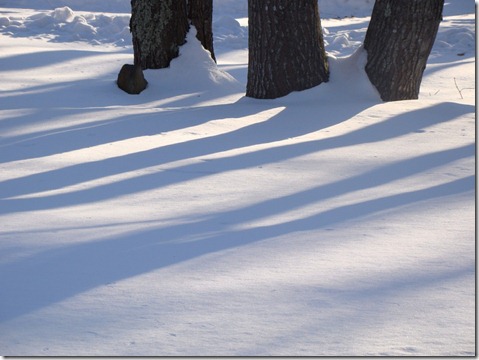
Among the hardest scenes for the landscape photographer to capture, snow has to rank right up there at the top. In sunlight, a snow covered landscape exceeds the light sensitivity range of our eyes…let alone a digital camera sensor. Even in lower light levels, under overcast skies or while it is actually snowing, it is very difficult to balance exposure in camera to produce white snow with significant texture and detail, and true to life colors where color is showing. If the snow is right, everything else in the scene is dark gray to black…which is one reason so may photographers resort to black and white when shooting snow scenes.
Over the New Year’s holiday we got significant amounts of fresh snow here in southern Maine, so, of course, I was out with my camera. That first day I was out while it was actually snowing. Light levels were subdued,the sky was a dark grey blur, and there was a lot of snow still in the air, closing horizons like fog. I was out a few hours and had a chance to reflect on the process of capturing a snowy landscape.
In subdued light, without any direct sun, I find that my camera responds best if I simply leave it on Programmed Auto. This produces a balanced exposure with enough detail in the snow so that I can bring it down and out in Lightroom, and enough color in whatever is still showing color so that I can bring it up and out.
Here is a shot, just as it came from the camera (just resized for display here).
As you can see, the snow is kind of gray, and there is little to no color in the beach grasses.
A trip through Lightroom results in this image.

I applied Recovery to bring out what little detail is in the snow and sky, then Fill Light for the color. The Blackpoint is shifted right, and I added Clarity (local contrast) and Vibrance (selective saturation) and finally used the Sharpen Landscape preset. I increased Contrast overall just slightly.
This image is very close to my visual impression of the scene when taken.
Here is another, somewhat classic shot.
In camera exposure is not very spectacular…but the information is all there for post-processing.

Using almost exactly the same processing in Lightroom as the first image I was able to preserve the snow detail while bringing out the color in the evergreens.
One more from the subdued light series.

The differences here are more subtle but there is an increase in both snow detail and color.
The key here is that I am working with a balanced exposure, as provided by the auto exposure system in the camera, with no manipulation, then doing all my adjustments in post-processing. Of course this is only possible if you know both how your camera is going to respond to these kinds of scenes and what you are able to do in software afterwards. Both in camera exposure and post-processing are part of the creative process, and part of the envisioning of the image when it is being taken.
I can’t emphasize that enough. What you are going to be able to do in post has to be part of your exposure decision in camera.
Of course, eventually the sun does come out. It might be days later, as it was in Maine, but the sun completely transforms the exposure issue for snow covered landscape.
Most people require sunglasses to deal with sun on snow. I use a wide brimmed hat. Whatever it takes, even our unprotected eyes can be overwhelmed by the glare of light when the sun shines on snow.
If your eyes can’t handle it, there is absolutely no chance the digital sensor in our cameras can. With sun on show you really have no good choices. Either you expose for the sky and any color in the scene, and the snow goes completely white and featureless, or you expose for the snow, and everything else goes black. Even if you expose for the snow, you run the risk of getting grey snow with very few highlights, and that does not look real either. No good choices.
The usual way of dealing with snow and sun is to use Exposure Compensation. Most digital cameras, when placed in Programmed Auto mode, will allow you to shift the EV (Exposure Value) up or down by 2 points. Each 1 EV change is equivalent to doubling or halving the exposure. Some cameras have a dedicated button for this, or an easy to find menu option. Some have it buried in the menu system…though it is generally fairly near the top since it is often used.
Conventional exposure wisdom says that for sunny snow covered landscape or sun on snow details you should reduce the exposure by –.7 to –1 EV. Here are two examples of the difference that makes. Standard Programmed auto shot first then –.7EV.
As you see, standard Programmed Auto produces large areas of snow that is totally burned out…so white there is no detail left. It does, however, keep the dark areas in the scene reasonably exposed. Dialing down the EV to –.7 keeps more detail in the sunniest areas of snow, but casts everything else, including shadows on the snow, way too dark.
That’s okay though…we are not looking at these as finished exposures, but as starting points for post processing. The question is, with proper processing which will capture more of the detail of the natural scene?
This the first programmed auto image processed in Lightroom. I used heavy Recovery for the snow highlights, a touch of Fill Light for the shadows, blackpoint just to the right, added Clarity and Vibrance and Sharpen Landscape preset.
Here is the –.7 EV image processed.

Much less Recovery, though still some. Much more Fill Light for the shadows, and consequently blackpoint further right. Added Clarity and Vibrance and Sharpen Landscapes. Because the shadows are darker the blue cast common in sun on snow shots was much more pronounced in this image, so I used the selective saturation tool to desaturate just the blue of the shadows.
Which is closer to a naked eye view? Which is a better image? I prefer the second shot which started with –.7EV.
On the other hand, there is the theory that conentional auto exposure of sun on show sets the exposure too low…for the snow…and everything else goes dark while the snow looses it whiteness. This is especially true in shots of people against snow backgrounds in full sun. Here are two shots, one at 0EV and one at +.7EV
As you see, the snow is white in the +EV shot and the trees look more natural. However, with processing in Lightroom, the 0EV shot (darker) still yielded the more satisfying image.

Here is an extreme.
I shot this close up of an area of intense sun on snow at –.7EV.
Way too dark.
Processing in Lightroom, plus a little cropping, (with a good deal of desaturation of the blue shadows) gives us this.

In general I had more success processing –.7EV shots on this sunny day than I did with standard Programmed auto shots. I did not like the +EV shots.
So, what do you do if your camera does not have EV Exposure Compensation settings? Some don’t. Most do however have Scene Mode…and one of the Modes included is almost certainly Snow or Sand & Snow.
However, these Modes are based on the assumption that you are taking images of people against a snowy backdrop…they increase exposure, generally by .5 to 1EV. And that is good. For people shots or if your primary interest is objects in the foreground. For Snowy Landscapes, however, it might just be counterproductive…especially if you consider the in-camera exposure as only a starting point for post-processing. If, on the other hand, you are not going to post-process, the Snow Mode may indeed give you more satisfactory snow scenes.
Take these two shots right from the camera. The first is conventional Programmed auto and the second is Snow Mode.
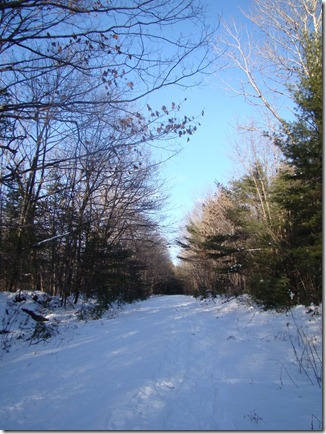 The second shot looks a bit more natural to me.
The second shot looks a bit more natural to me.
Again.
and
If I were processing these…the first in each case would make the better image, given the tools I have in Lightroom. If using them direct from the camera, however, there is no doubt that the Snow Mode does its job and produces a better snow image.
So. Let it snow. Let it show. Shoot the snow.
Just know what your camera is capable of, and what you are able to do in whatever post processing program you prefer. Expose in camera for best post.
Let it snow. Shoot snowy landscapes!

